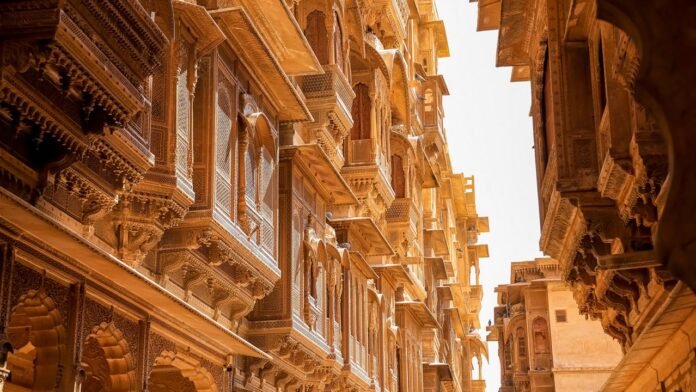Patwon Ki Haveli, located in Jaisalmer, Rajasthan, is one of the most iconic and beautiful heritage sites in India. It is a must-visit destination for anyone exploring the historical richness of Jaisalmer. With its intricate architecture and historical significance, Patwon Ki Haveli has become a symbol of Rajasthan’s grandeur and royal heritage. This stunning monument is a showcase of the traditional art and design of the region and is an important part of Jaisalmer’s rich cultural heritage.
Historical Background
Patwon Ki Haveli was built by a wealthy merchant, Guman Chand Patwa, and it is actually a group of five havelis, constructed in the early 19th century. The havelis were originally meant to reflect the lavish lifestyle of their owners, and they stand as an architectural marvel today. The uniqueness of Patwon Ki Haveli lies in its detailed craftsmanship and the history that it represents. Visitors can explore this beautiful heritage site and experience the grandeur of Rajasthan’s royal architecture. The havelis were designed with intricate carvings, jharokhas (overhanging balconies), and sandstone facades that reflect the skilled craftsmanship of the time.
Architecture and Design
The architecture of Patwon Ki Haveli is a blend of traditional Rajput and Islamic styles, making it a beautiful example of the diverse architectural influences found in Rajasthan. The stunning carvings on the walls, the elaborate arches, and the open courtyards are perfect examples of the artistic talent and attention to detail that went into the construction of this magnificent structure. As you explore the haveli, you will notice the delicate artwork that adorns the ceilings and walls, as well as the expansive windows that allowed natural light to illuminate the interiors.
One of the most interesting features of the haveli is the “jharokha” balconies, which were used by the royal families to observe the activities in the courtyards and streets below. These balconies are intricately carved and provide a beautiful view of the surrounding areas. The entire haveli is a testament to the architectural brilliance of the craftsmen of that era. For those who enjoy exploring heritage sites, Patwon Ki Haveli offers a delightful experience.
A Cultural Experience
Visiting Patwon Ki Haveli is not just about admiring its architectural beauty; it also offers visitors a glimpse into the rich cultural heritage of Rajasthan. Inside the havelis, you can see a collection of antique items, including paintings, furniture, and historical artifacts that tell the story of the people who once lived there. The heritage site offers a chance to understand the lifestyle, traditions, and customs of the wealthy merchants of the past.
The haveli also holds cultural significance as it highlights the prosperity of Jaisalmer during the time of its construction. The intricate designs and vastness of the havelis were a symbol of the merchant’s wealth and status, and they stand as an important reminder of Jaisalmer’s historical significance in the region’s trade and commerce. As you explore Patwon Ki Haveli, you can immerse yourself in the history of Rajasthan and the city of Jaisalmer.
Things to Do at Patwon Ki Haveli
When visiting Patwon Ki Haveli, there are several activities that visitors can enjoy. Exploring the structure itself is an absolute must, as it will take you through different rooms and courtyards, each with its own historical significance. Be sure to look up at the beautifully detailed ceilings and notice the exquisite craftsmanship in every corner. You can also take time to photograph the stunning carvings and architecture, which will make for great memories of your trip to Jaisalmer.
Aside from the haveli, there are plenty of other things to do in Jaisalmer. If you’re planning your visit to Patwon Ki Haveli, consider making it part of a broader exploration of the city. After a day of sightseeing, you can unwind with a relaxing experience at a Camp In Jaisalmer. The desert landscape of Jaisalmer offers a magical experience, and staying at a Camp In Jaisalmer allows you to enjoy the peaceful surroundings, away from the hustle and bustle of city life.
Another highlight of visiting Jaisalmer is the opportunity to enjoy a Dinner on Dunes. There’s something truly special about dining under the stars while surrounded by the vast, golden sands of the Thar Desert. Many camps offer this unique experience, where you can enjoy a traditional Rajasthani dinner while watching the sun set over the dunes.
Best Time to Visit
The best time to visit Patwon Ki Haveli and Jaisalmer is between October and March, as the weather during these months is pleasant and ideal for sightseeing. During the winter months, you can enjoy the cool breeze and explore the heritage sites without the extreme heat of the summer. The early morning and late afternoon are the best times to visit Patwon Ki Haveli, as the lighting is perfect for capturing the intricate details of the architecture.
If you’re planning to visit during the summer months, make sure to stay in a comfortable Camp In Jaisalmer where you can cool off and relax after a day of exploring. The desert atmosphere can be quite hot, but a night under the stars in a luxury camp can be a refreshing experience.
Conclusion
Patwon Ki Haveli is undoubtedly one of the most beautiful and historically significant heritage sites in Jaisalmer. Its architectural beauty, cultural value, and historical importance make it a must-visit destination for anyone traveling to Rajasthan. Whether you’re interested in exploring the intricate carvings, learning about the history of Jaisalmer, or simply enjoying the picturesque surroundings, Patwon Ki Haveli offers something for every traveler.
Make sure to plan your visit carefully and consider staying at a Camp In Jaisalmer to complete your desert experience. After a day of exploring the historical marvels of Jaisalmer, you can enjoy a Dinner on Dunes, making your trip truly unforgettable. For a luxurious and relaxing experience, stay at Desert Dream Royal Camp, where you can enjoy the beauty of the desert in comfort and style.



